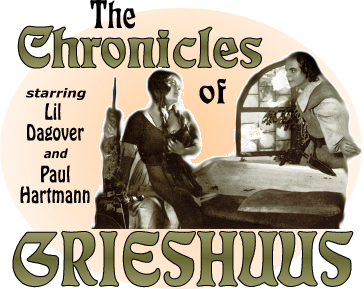

The 1919-1924 period of the German Cinema is chiefly remembered for films based on fantasy, legend, and saga. "Caligari," "Dracula," "Destiny," "Siegfried," "The Golem," "Cinderella," and "The Chronicles of Grieshuus" are all typical. In every case the outstanding production phases are the design and architecture, the "atmosphere," and the large-scale realisation. The acting is fraught with a naturalistic charm; the direction is fairly profound; the scenario thoughtful and detailed. Humour is (excepting "Cinderella") conspicuously absent; and, what is more serious, the montage is so elementary as to be, in parts, obviously incorrect. The direction thus falls short of full technical cinematographic application, and, therefore, a slowness of narration and a tendency towards the theatrical keeps intruding as noted in "Caligari" and "Siegfried." These defects are, however, offset by the compositional excellence of the photography.
"The Chronicles of Grieshuus" was shot at the
same Neubabelsberg studios (near Berlin) and in the same year
as "Siegfried" and "Cinderella" and has the
added 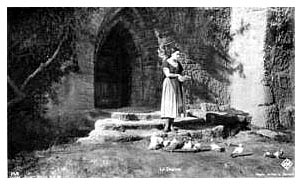 connection of the same scenario-writer
as the former, and the same leading man as the latter. The scenario
is typical of Thea von Harbou's earlier work and is made up of
a series of episodes contained between fades. The construction
is sound but too elementary to be of great interest, a fault noticed
in "Siegfried." It was in "Metropolis" that
this writer made a marked improvement when the same logical development
was maintained without the irritatingly episodic style - and too
short chapters. A more advanced construction is to be preferred
with more sustained sequences and a better flow of action
(rather than a succession of bits), as in "The Lighthouse
by the Sea."
connection of the same scenario-writer
as the former, and the same leading man as the latter. The scenario
is typical of Thea von Harbou's earlier work and is made up of
a series of episodes contained between fades. The construction
is sound but too elementary to be of great interest, a fault noticed
in "Siegfried." It was in "Metropolis" that
this writer made a marked improvement when the same logical development
was maintained without the irritatingly episodic style - and too
short chapters. A more advanced construction is to be preferred
with more sustained sequences and a better flow of action
(rather than a succession of bits), as in "The Lighthouse
by the Sea."
The legend of Grieshuus castle concerns the love of the elder son, Heinrich, for Greta, the daughter of an old servant, as a result of which the son is disinherited. The father dies of a seizure when the younger son, Detlev, begs the inheritance. Heinrich and Greta settle happily in a tower away from the deserted castle. Detlev returns to seize the inheritance by suggesting that Heinrich's marriage has lowered him to a serf and creates a terrible scene with Greta, who dies giving birth to a son. Heinrich avenges this by killing Detlev, then wanders away, an outcast. Years pass, and Detlev's widow plans to secure the castle by kidnapping the son and heir, Rolf, but Heinrich returns, and Greta, appearing in ghostly form, leads him to rescue the child. And, though mortally wounded in the struggle with the kidnapper, Heinrich carries his son back to the castle, and so the rightful heir to Grieshuus is established.
The only unusual twist in this straightforward narrative is the appearance of Greta as a spirit towards the end, which provides an interesting solution to the dramatic situation and is fairly typical of such legends. The film presents the story without sidetracks, digressing only for characteristic incidentals. The players are impeccably excellent in appearance, deportment, and costume, and the acting is vigorous rather than subtle. Standards in acting fluctuate, and at one melodramatic point, Greta windmills ludicrously, just as did Sarah Bernhardt in "The Lady of the Camellias."
Born in Java in 1894, Lil Dagover was one of the outstanding European actresses, though it must be remarked that she never showed really outstanding ability, being rather fortunate in her assignments. From "Caligari" through "Destiny," "The Count of Monte Cristo," "Mayerling," "Tartuffe," "Hungarian Rhapsody," "The White Devil" (with dubbed English dialogue), "Congress Dances," to "La Barbarian," wherein she also sang with unexpected accomplishment, she is associated with some of Cinema's more interesting achievements. Her one trip to America for F.N. added nothing to her reputation. I last saw her at a Munich cinema in "Ein Frau die weisst wie sie will," a mediocre affair typical of the Hitlerized German cinema, which never reached England. The same depressing mediocrity marked Thea von Harbou's scenario for Emil Janning's last film, "The Ironmaster," which goes to prove that art is better served by inspiration than brute force.
Arthur von Gerlach is associated with one other famous film,
"Vanina" (1922, with Paul Wegener, Paul Hartmann and
Asta Nielson). He lacked the detailed control of F.W. Murnau and
the stylish mannerisms of Fritz Lang, but handled his players
carefully. Good grouping is frequently in evidence, as in the
crypt scene - and there are 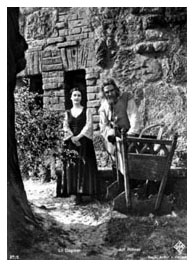 some
nice "asides" such as the whisperings of the congregation
as the final shot of the church sequence fades out.
some
nice "asides" such as the whisperings of the congregation
as the final shot of the church sequence fades out.
The director was also very well served by his set designers. Herlth and Röhrig are remembered equally for "Caligari," "Tartuffe," "Faust," and "The Wonderful Lie," all famous for the artistry of their sets - and "Grieshuus" contains some of their best work. One has only to recall the simple beauty of the church, Greta's room in Landes Tower, and the hall and stair of the castle to realise how fine in conception and realisation are the settings of this legendary chronicle. The exteriors are equally memorable, both purely and naturally, and the designed exterior, such as the castle entrance.
All this excellent material and talent could, however, be wasted and yield only a mediocre film if the cameraman lacked inspiration and talent. But happily "The Chronicles of Grieshuus" was shot by perhaps the best of all cameramen - Fritz Arno Wagner. It is undoubtedly the quality of his work that sets this film among the "Classics." We have previously discussed excellent cameramen - Freund for "Metropolis," "Vaudeville" and "Faust;" Krampf for "Cinderella;" and Hoffman for "Siegfried." But no one of them has maintained the perfection with which all Fritz Arno Wagner's work has been endowed. Examples are needed to substantiate this sweeping statement. Compare the full close-ups in "Siegfried" with those in "Grieshuus." The former are static portraits; the latter are alive with light and shade and subtlety of arrangement so that the whole frame is filled with a living composition. Again, recall the expression of mood in the exteriors. Gaiety, struggle, and bleak despair are portrayed as required. For interiors, compare the (excellent) "Cinderella" shots in the Fairy Godmother's room with the (perfect) "Grieshuus" shots in the Knights room with Detlev. The latter are decidedly superior in lighting and camera angle.
This wizard cameraman was born in Thuringia in 1889 and worked as a secretary and a reporter in New York and Mexico before returning to Germany for the 1914 war. Through the German General Staff film section, he went over to films in 1920 as a cameraman. Naturally, he worked on many famous films for many famous directors. "Warning Shadows" (Arthur Robison), "Nosferatu" (F.W. Murnau), "At the Edge of the World" (Karl Grune), "The Love of Jenne Ney" (G.W. Pabst), "The Spy" (Fritz Lang), as well as the later "Kameradschaft" and "Testament of Dr. Mabuse," form a redoubtable but incomplete list - and each was an exceptional photographic achievement.
The film opens with two tracking shots; the first tracks back to show the castle after a delayed iris-in of the crest carved over the main gate. The second tracks in through the gates into the vast courtyard. Heinrich is introduced in the castle porch. His horse is led up, and his servant brings his two huge dogs who make a fine fuss of him. At a window above are the Knight of Grieshuus with his servant, Old Heiken. Heinrich rides off - seen from their viewpoint - and across the courtyard amidst scampering children and chickens, and out and away, in a fine long shot. One only regrets the shortness of the sequence, for the old castle is drenched with sunlight, the people and animals are pleasant to look at, and happiness and vitality abound. Fritz Arno Wagner has caught and maintained the joyous atmosphere.
Heinrich rides by a cottage nestled in a hollow. In a patterned
close-up, framed with sunflowers, Greta is introduced. Heinrich
sits astride his horse, the wind blowing through him - a fine
shot. Suddenly, over the hill, a band of vagabonds approaches
the cottage. Greta sees, dashes inside, and bars the door. The
exterior long shots have excellent counterpoint but are too subtle
to be appreciated at first viewing, perhaps due to pruning. The
cottage interior is a grand conception of beams and leaded windows,
through one of which Greta escapes as the door is battered in.
The vagabonds give chase and catch her and bind her to a tree
in the garden whilst setting about  burning
her property. But the row has excited Heinrich's dogs, so he rides
to the rescue, beats up the five vagabonds single-handed, and
rather ingeniously puts them to flight by throwing a skep of bees
after them. All this action is well handled in rollicking style,
most unusual in a European film of this period. The cottage exteriors
are fascinatingly perfect in all detail. The vagabonds nurse their
stings while Heinrich takes Greta to the Castle.
burning
her property. But the row has excited Heinrich's dogs, so he rides
to the rescue, beats up the five vagabonds single-handed, and
rather ingeniously puts them to flight by throwing a skep of bees
after them. All this action is well handled in rollicking style,
most unusual in a European film of this period. The cottage exteriors
are fascinatingly perfect in all detail. The vagabonds nurse their
stings while Heinrich takes Greta to the Castle.
Washerwomen by a limpid brook fed from a little waterfall, men of the farm aloft haymaking, and the servants who swing open the massive entrance gates all stare curiously as the two ride in. The Knight of Grieshuus and old Heiken stand in the porch. Greta runs up to her embarrassed father and explains. So Heiken stoops to kiss the young Lord's hand, but Heinrich hastily withdraws. And the old Knight, watching, realises the situation and gives permission for them to remain at Landes Tower . . . but Greta is not to meet Heinrich again. From the picturesque first three long-shots, this sequence is excellent both in direction and acting. The narrative situation and relationships of the characters are fairly complex, but clearly and economically stated. The use of supplementary lighting explains the remarkable depth and modeling of the photography.
"My daughter isn't here," says Old Heiken to Heinrich who has (as we expected) called at Landes Tower (the Grieshuus crest is over the door). But Greta has heard from her room where she is spinning whilst the sun streams in, throwing a dancing pattern on the wall from a swaying bough outside, and she sings. Heinrich laughs and climbs the old tree and appears at the window. The sparkling sunlight catches them both . . .
The Knight of Grieshuus paces his austere room, worried. He reads over his will, appointing Heinrich his heir. Heinrich enters and states his wish to marry Greta. The curt parchment, the long room, the carving and the cold stone, all fit in with the tradition of the old Knight. Stormily he replies, "The daughter of a serf! Have I not already refused my consent!" and tears the will in two.
In vast high-angle long shot, in an open sedan chair borne by four servants, Detlev arrives and meets his father and brother in the porch. The handclasps are hesitant. Detlev is an outsider, a fact conveyed by the director without need of the explanatory title.
A short, fresh sequence of Greta with pigeons (reminiscent of "Cinderella") and Heinrich with his dogs culminates in their meeting in a happy embrace, but old Heiken is worried.
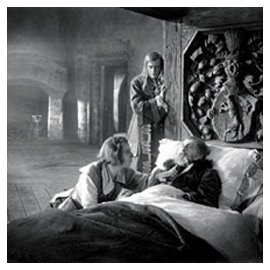 In the main hall of the Castle,
a very beautiful set, Detlev announces his engagement to the Countess
Orlamunde and asks his father's intentions regarding the estate.
His close-up is ideally arranged as he stoops crookedly forward
to speak. The Knight rises slowly to his feet. Detlev straightens
uneasily. In fiercely dramatic CM.S. with violently contrasted
lighting, the Knight refuses to appoint an heir and grasps a vessel
of wine, but has a seizure and collapses. In low-angle M.S. he
fills the foreground as Detlev shrinks back . . . Heinrich is
at Landes Tower with Greta when his servant rides up with the
news. . . the sombre death-bed scene is remarkable for its lighting.
The key is low, but the characters stand right out from the misty
background.
In the main hall of the Castle,
a very beautiful set, Detlev announces his engagement to the Countess
Orlamunde and asks his father's intentions regarding the estate.
His close-up is ideally arranged as he stoops crookedly forward
to speak. The Knight rises slowly to his feet. Detlev straightens
uneasily. In fiercely dramatic CM.S. with violently contrasted
lighting, the Knight refuses to appoint an heir and grasps a vessel
of wine, but has a seizure and collapses. In low-angle M.S. he
fills the foreground as Detlev shrinks back . . . Heinrich is
at Landes Tower with Greta when his servant rides up with the
news. . . the sombre death-bed scene is remarkable for its lighting.
The key is low, but the characters stand right out from the misty
background.
A bell tolls. Six men carry the coffin. Heinrich and Greta lead the mourners. Detlev refuses a salute. The coffin is borne to the family crypt. The priest reads the service. Detail shots show Heiken with Heinrich's servant, and Old Matten (the chatlaine, never properly introduced in the available version) in black, clasping her book. All kneel in a lovely long shot from within the crypt with the crowd filling the rising path outside the picture, framed with the sombre black of the interior. In mid-shot the prayer is concluded too abruptly, and the title is ill-worded and ungrammatical. Heinrich asks, "Reverend Father, will you marry Greta and I?" C.S. Greta looks up, takes his hand. M.S. the priest blesses them, bows. Cut short to "End of Part One." This is abbreviation run riot, and (apart from inserting a foot of blank film before the shattering appearance of the part tag) a slight lessening of the jar can be achieved in the musical accompaniment. Throughout the funeral scene, the Funeral March from the Otello Suite (HMV B.4274) is played, but starting at the above quoted title peals of bells (Columbia YB.8) are slowly faded-in on the second turntable after which the funeral march is slowly faded out.
A year later we find old Heiken playing with a newly acquired cradle while Greta watches, smiling. The long shot is charmingly framed by the trunk and bough of a spreading tree. Heinrich worries over the empty castle, but Detlev covets the inheritance, and with Orlamunde, his wife (her close-up expresses the cruelty behind her beauty), he drives up to the castle in his fine coach drawn by four thoroughbreds. Heinrich's servant refuses them admittance. A dramatic low angle shot covers the tense moment on the porch. Detlev considers, confers with Orlamunde, and in full long shot they return to their coach . . . fade out.
The Church sequence is one of the best in the film. In the
opening bold long shot, the congregation lining the approach,
a carriage stops on the hill in the foreground, and Heinrich tenderly
helps his wife to alight. They enter, shown deference by all,
and inside climb the stair to the raised stall reserved for the
use of the Knights of Grieshuus. Each of the several shots has
some new detail of architecture or moulding or sculpture in the
background. In another exterior long shot, giving a different
angle on the church, Detlev and Orlamunde drive up. Inside, Heinrich
and Greta kneel. The Priest turns to the congregation, a fine
close-medium shot, two candles forming the background on the severely
simple altar. Then . . .
(a) L.S. members of the congregation look round . . .
(b) L.S. (from altar) Detlev and Orlamunde enter,
(c) M.S. Detlev striding forward . . .
(d) M.S. Greta and Heinrich look round
(e) SM.S. Detlev exclaims to Heinrich, loudly,
(f) TITLE "Do you forget that in marrying a servant's daughter
you lose your rights as Knight?"
(g) M.S. Heinrich starts to his feet, handles sword, Greta restrains
him.
(h) M.S. (as c and e) Detlev strides back, looks round.
(i) L.S. (high angles) members of congregations all look at him
(j) L.S. (from entrance) Detlev and Orlamunde stride down the
aisle
(k) SM.S Old Heiken and Matten look troubled.
(l) L.S. Heinrich desires the priest to continue.
(m) SM.S. Priest turns to his Book.
(n) L.S. (as j) Service resumes, but there are whisperings and
noddings.
Fade out.
It will be noted that the material is well arranged, but words cannot do justice to the beauty and authenticity of this church interior which is seen from all angles. Outstanding features are the balcony, seen in (b), and the absolutely characteristic shadows on the aisle in (j) and (n) . . .
One evening, with Heinrich away from Landes Tower, Detlev
intrudes on Greta and Old Matten. Greta's fingers move nervously.
The C.S. of old Matten as she withdraws 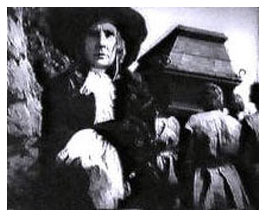 lingers
on her hand slowly leaving a chair-back, an excellently expressive
detail. Heavily contrasted in lighting, Detlev, in a sinister
close-up, produces a parchment . . .
lingers
on her hand slowly leaving a chair-back, an excellently expressive
detail. Heavily contrasted in lighting, Detlev, in a sinister
close-up, produces a parchment . . .
"If a man of noble birth takes a serf to wife, he not only loses his rights as master, but becomes a serf himself."
A knotted vein in Detlev's forehead stands out with ugly ferocity, caught by strong side lighting. He suggests she leave Grieshuus. She screams, distraught. Old Heiken enters, begs mercy. The whole is lit with a sharp, angular intensity. Greta, with a wide gesture, indicates the door. Detlev slowly withdraws. Emotion overpowers Greta. She clutches her throat and collapses. In twilight long shot, Landes Tower in the distance, Detlev rides away. Heiken and Matten tend Greta who is clearly (only too clearly by modern acting standards) upset. Then, frighteningly redundant and in large thick lettering comes a placard:
"Detlev's words came as a terrible shock to Greta."
This title should be painlessly extracted. Matten looks out from the balcony. A lone rider is silhouetted on the horizon. She returns to Greta's bedside while Heiken meets Heinrich, explains, takes his horse. Then . . .
(a) L.S. Heinrich enters . . .
(b) CM.S. Stands in doorway, exclaims, "Bärbe,"
runs forward . . .
(c) C.S. Greta, eyes shining, arms outstretched. . .
(d) M.S. The same, Heinrich passes old Matten, kneels by the bed.
. .
(e) CM.S. The same, he speaks agitatedly to her
(f) TITLE "You mustn't die, Greta. You know we will never
be parted."
(g) CM.S. (as e) He says
(h) TITLE "Nothing will ever make me renounce you."
(i) CM.S. (as g) She tries to restrain him, but he gets up
(j) CM.S. Speaks to old Matten
(k) L.S. Tears himself away from her; she goes to Greta's side.
(l) L.S. (vertical pan) He hurries down the stair, pauses. . .
. . . because he sees the parchment Detlev brought. The cutting of this sequence is faulty, shots (c) and (d) being too long, so that the turbulent rhythm is lost. The action in (d) - (e) overlaps, proving that the technique of cutting on action was not understood. The single shot (e-g-i) is well arranged and acted. (b) is interesting. Bärbe was the girl's name in the original, and her re-christening as Greta is somebody's unaccountable shim. The titles are trite in content and idiom - a fault throughout the film.
Directed by his servant at the castle, Heinrich rides in pursuit of Detlev. Wind moans round Landes Tower. Greta's son is born.
Heinrich overtakes Detlev, produces the parchment, accuses him . . .
(a) CM.S. (low angle) Slashes forward with his sword . .
.
(b) L.S. Old Matten witnesses, in horror
(c) M.S. (low angle) Detlev's hands loosen, his legs slide from
this horse, Heinrich leans tensely forward.
(d) M.S. (high angles) Detlev falls backwards on to rocky ledge
. . .
(e) L.L. (low angle) (from behind) . . . end of fall, Heinrich
on horse in background, slowly dismounts.
Heinrich slowly looks, then turns away in horror, and rides
away into the distance. Old Matten struggles back through the
wind to Landes Tower and finds only the child alive. In a grim
long shot with enormous depth of focus, she shuffles to the stair,
carrying the baby whilst through the door can be seen Greta .
. . and in a lovely but eerie 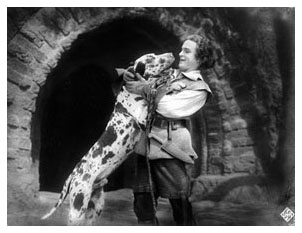 dark-fringed
close-up, the chill wind ruffles her still body and twisted autumn
leaves drift on to the bed. In three cold long shots, buffeted
by the gale, old Matten carries the child past the wind-swept
shrubs and through the drifting leaves up to the castle. Detlev's
horse stands guard over his body. Heinrich slowly rides away into
the darkening twilight. Fade out. (End of reel 2)
dark-fringed
close-up, the chill wind ruffles her still body and twisted autumn
leaves drift on to the bed. In three cold long shots, buffeted
by the gale, old Matten carries the child past the wind-swept
shrubs and through the drifting leaves up to the castle. Detlev's
horse stands guard over his body. Heinrich slowly rides away into
the darkening twilight. Fade out. (End of reel 2)
Eights years later, Heinrich chances to return to Grieshuus. Landes Tower is neglected, covered in creeper. He sits by the door, bowed with memories. Young Rolf (introduced with Old Matten by a roaring fire in the castle the previous night) plays with a toy crossbow; an arrow lands by Heinrich. They meet, father recognizes son, and indeed the lad's resemblance to Greta is remarkable. Similarly Paul Hartmann, now with beard but not too aged in appearance, resembles his father. The make-up is excellent, and the attention to detail exemplary.
That evening Heinrich seeks shelter in the inn, another magnificent set, grandly lit and peopled with excellent types. Among the gossip it is learned that Widow Detlev is planning to wrest the Grieshuus estate from Rolf, the rightful heir. At this point the quality of the scenario improves. Continuous action is sustained to the end, and at one point three simultaneous scenes are intercut efficiently, though suspense values are lacking.
Orlamunde rides up to the castle with two servants, asks shelter, is admitted. Servants with torches light them across the courtyard, a superb full long shot. Young Rolf watches from a window. Old Heiken bows her in. She says to Rolf, "I hope we shall be good friends, nephew." Old Matten furiously insults her and is cynically ignored. At the village inn, Heinrich retires to bed. At the castle, Orlamunde and her servant watch as old Heiken takes Rolf to bed. Horses are in waiting by the river. Rolf is tucked in his huge, finely carved bed. Far down the stair, Orlamunde watches till Heiken leaves, then enters the bedroom. The dim-lit stair-head is handsome, flanked with intersecting arches, and with the Grieshuus crest on one wall. In long shot over Orlamunde's shoulder as she stands by the open door looking towards Rolf in bed, there fades the misty figure of Greta, as it were guarding her son. In C.S. Orlamunde, wide-eyed, recoils, retreats from the room, retreats down the stair. In CM.S. Rolf turns towards the spirit of his mother. She smiles at him, and withdraws, and in mid-shot fades again into the dim wall by the bed.
Orlamunde having returned empty-handed to the rendezvous beneath the wall of the castle, her servant goes to do the job. Greta then appears to Heinrich, leads him out to his horse. The servant seizes Rolf (this time the bedroom is shot from a low angle looking towards the door). Something rouses old Heiken. At the rendezvous, they start their getaway, prefaced by another unnecessary and ludicrously worded title, "Cross the river with all speed, then hurry." Fording the black waters of the river is excellently done in full long shot.
Meanwhile torch aloft, Heiken hurries down the stair, gives the alarm. Orlamunde, servants and Rolf have crossed the river. The long shot with them in foreground shows the castle bank in the background, fully establishing the geography. Dramatically, with lively movement across the screen, servants with torches stream out of the castle, and in full long shot, some mounted, they sweep from the courtyard gate, the castle dimly discerned against the dark night sky.
Far across the heath Greta can be seen, a ghostly white figure, disappearing as Heinrich takes the right direction. The servant carrying Rolf sees his pursuer, turns, and sets down the child. But Heinrich rides up. The encounter is staged on top of a cliff. In L.S. they grapple. In low angle M.S., Heinrich turns his head for a moment to look towards his son, and the servant plunges a dagger in his side and gets away. Heinrich staggers to Rolf in a magnificently composed picture - the white horse filling the right margin, Heinrich off-centre foreground, all brightly white against the almost black of the heath and sky. The white horse follows as Heinrich slowly carries the boy back to Grieshuus castle, and Greta, preceding them, disappears for the last time as the great doors are swung open again. Heiken runs forward, torch aloft . . .
(a) CM.S. Faces his master and exclaims
(b) TITLE "Heinrich! Heinrich!"
(c) CM.S. Sinks out of the frame, to kneel at his feet.
(d) L.S. Other servants come up, all make way as he moves forward
. . .
(e) L.S. (framed by two torch-bearers) He enters the castle.
(f) L.S. (through arch of door) He proceeds up the stair.
(g) L.S. (Old Matten in foreground) Door is opened by Heiken;
Heinrich appears from stair and enters.
(h) CM.S. Old Matten moves forward.
(i) ML.S. Heinrich staggers. Heiken stands by him; Old Matten
kneels at his feet.
(j) CM.S. He looks at Rolf in his arms.
(k) M.S. He sinks down in the old carved chair by the fire.
(l) SM.S. (Heiken stands near) He says,
(m) TITLE "How like Greta he is!"
(n) CM.S. (as l) . . . and looks intently at his son. Heiken smiles.
Heinrich looks at Rolf (over Heinrich's shoulder); Rolf puts a
hand on his shoulder
(o) TITLE "Daddy!"
(p) C.S. (as p) and rests his head against his father.
(q) C.S. Heinrich fondles him; then his hands relax, his head
sinks back.
(r) CM.S. A torch burning in a holder by an arch. It wavers, goes
out. The shot darkens, smoke eddies away. Slow fade-out.
The tempo of this closing sequence is admirable. The greeting (a to d) is finely acted and quite emotional. The series of long shots (d to g) are finely photographed. The castle atmosphere pervades each composition, and the impression of the heir to Grieshuus returning to his own is excellently wrought. As the sequence becomes more intimate, there come the medium close-ups (h to n), and finally we have full close-ups of Heinrich and Rolf, as the inheritance of Grieshuus passes from Father to Son . . . the torch fades to be rekindled in the new heir. The two titles (m and q) are redundant. The second is thoroughly objectionable and should be removed.
Von Gerlach indeed did well with his sustained atmosphere, carefully drawn characters (e.g. Detlev and Orlamunde's attitude with servants), handling of crowd scenes (mourners, servants, men in tavern) and arrangement of incidental material (e.g. sunshine, wind, night). All these may be the ingredients of a good script, but upon the generalship of the director depends the success of their realisation. Superior opportunities were not so well exploited, for example, in "The Lost World." It is remarkable that this accomplished director made no further notable films.
The dying flame of the torch in the last shot is memorable. One can imagine a contemporary Hollywood version ending with Heinrich's spirit floating upwards and rejoining that of Greta on the battlements of the castle in a luscious embrace, accompanied by the glorious sound of an angelic chorus (cf. "All Quiet on the Western Front). Definitely we must praise von Gerlach for his measured simplicity of treatment and dignified restraint, especially in the ghost scenes which might so easily have been ludicrous. His thoughtful direction, supported by charming actors and sets, and crystallized in the lovely art of Fritz Arno Wagner, has added to the archives of Cinema this memorable legend.